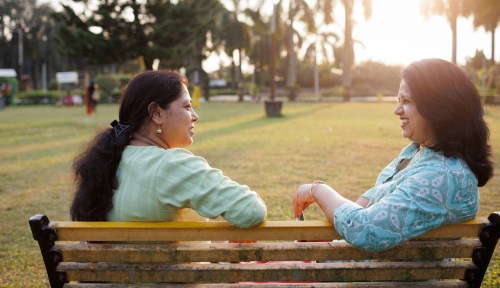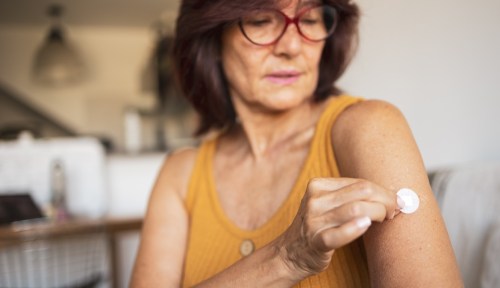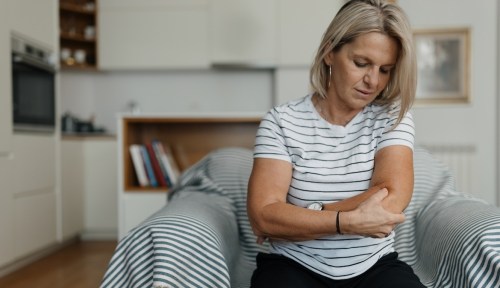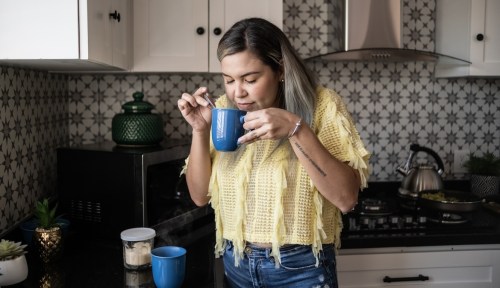Our editors independently select these products. Making a purchase through our links may earn Well+Good a commission
4 Ways To Improve Your Bone Health During Menopause (That You Can Start Implementing at Any Age)
Bone health and menopause may not feel connected, but this life stage can alter bone density. Learn how to keep your bones healthy for life.

There’s no denying that as we get older, the way our bodies move and feel changes. We may feel more stiff as we climb out of bed in the morning, or have a harder time touching our toes while warming up for a workout or doing yoga.
Experts in This Article
board-certified OB/GYN and author of Sex Rx: Hormones, Health, and Your Best Sex Ever
Yes, most of these symptoms are par for the course. But you may not realize that some of them actually stem from menopause—a life transition marked by the end of menstruation.
The most talked-about menopause symptoms are typically mood swings, hot flashes, and vaginal dryness—all largely due to shifts in hormones—but did you know your bones can be affected, too? More specifically, your bone density can decline during menopause, and like other symptoms, there’s no telling how long it will last.
Thankfully, there are ways to keep your bones healthy and strong during menopause, some of which can be started long before you even enter this post-menses period. Read on to learn more from an OB/GYN expert.
Why your bone density changes during menopause
Your bone density starts to decrease when estrogen levels dip during menopause, says Lauren Streicher, MD, an OB/GYN and founder of the Northwestern Medicine Center for Sexual Medicine and Menopause.
“Your bones are loaded with hormone receptors and are dependent on estrogen to both build new bone and prevent the breakdown of old bone,” she says. “When estrogen levels decline, that process gets disrupted. The result is bone that’s lower in density, more fragile, and more likely to fracture.”
Up to 20 percent of this bone loss happens within the first five years of menopause, per the Cleveland Clinic, which often begins between the ages of 45 and 55. Though some people can go through it earlier (age 40 or younger) due to genetics, a removal of the ovaries (which often happens with a hysterectomy), or other forms of medically induced menopause, per The North American Menopause Society.
“When estrogen levels decline, and bone building is disrupted, the result is bone that has a lower density, is more fragile, and is more likely to fracture.”—Lauren Streicher, MD, OB/GYN
How menopause can negatively affect bone health
The hormone fluctuations that happen during menopause can lead to a condition called osteoporosis—a disease that slowly weakens your bones, putting them at risk for fracture and breaks, per Penn Medicine.
Anyone can get osteoporosis, but “the loss of estrogen makes women five times more likely than men to have osteoporosis,” says Dr. Streicher. “This is because men’s bones continue to be protected by testosterone.”
Over time, osteoporosis can make your bones weaker, more fragile, and more prone to breaks. It also often goes undetected until you have a sudden fracture—usually in your back or hips—which is why it’s sometimes referred to as a “silent disease,” according to Dr. Streicher. And just because it’s common (affecting about 10 million women in the U.S. alone, per Dr. Streicher), doesn’t mean it comes without risk.
“If osteoporosis is advanced, you may notice a loss in height or back pain, but most people with low bone mass or osteoporosis have no idea they’re at risk for a potentially life-changing or fatal fracture,” says Dr. Streicher.
Deaths from hip fractures alone are rare these days, especially with all the technological advancements in medicine, but one February 2014 review in Acta Otrhopaedica1 (which collected data from 30 years’ worth of randomized controlled trials) found that the one-year death rate after a surgically treated hip fracture still sits at about 21 percent.
The best way you can determine your risk? Get a bone density assessment—also known as a DEXA scan.
“A DEXA scan measures bone density in your hips, spine, and sometimes your forearm,” says Dr. Streicher. “To determine your true risk of fracture, it’s also important to keep other risk factors in mind, such as age, smoking, steroid use, arthritis, and family history.”
The best time to get your first DEXA screening will largely depend on your risk factors, but should happen no later than age 65, adds Dr. Streicher.
4 ways to make your bones stronger during menopause
There’s no guarantee you can completely skirt the effects of bone density loss during menopause. But there are steps you can take (either during or well before you reach menopause) to help keep your bones as healthy and strong as possible. Here are some strategies to try, according to Dr. Streicher:
1. Do weight-bearing exercises
Any sort of exercise that puts healthy amounts of stress on our bones and muscles can help slow bone loss, and even spur the growth of new bone, per Harvard Health Publishing. This is called weight-bearing exercise, and it involves using your body weight and/or external weights (like dumbbells) to directly work the bones in your legs, hips, and lower spine, per the Mayo Clinic.
Some examples of these bone-strengthening exercises include walking, dancing, jogging, strength training, and resistance training. These exercises have other health benefits, too, like improving blood circulation and heart health, according to the Mayo Clinic.
A good rule of thumb: Aim to get at least 150 minutes of moderate-intensity exercise per week, including two days of muscle-strengthening activity, per the Centers for Disease Control and Prevention (CDC).
2. Eat foods high in calcium and vitamin D
The phrase, “you are what you eat” exists for a reason. For example, if you want strong, healthy bones, your diet should include foods to reflect that. One of the best nutrients for bone health is calcium—an essential micronutrient to keep your bones, heart, and muscles healthy, per the Mayo Clinic.
Calcium is especially important for people going through menopause when your risk of bone loss increases. That’s why Dr. Streicher recommends increasing your calcium intake during this time—to maintain bone health and help build new bone. While adults under 50 need about 1,000 milligrams of calcium per day, adults 50 and older need about 1,200 milligrams, per the Academy of Nutrition and Dietetics.
Because our bodies can’t produce calcium on their own, it’s important to make sure you’re getting enough through the foods you eat. Some foods high in calcium include the following:
- Milk or fortified soy milk
- Cheese
- Yogurt
- Dark leafy greens, like kale or spinach
- Soybeans
- Calcium-fortified tofu
- Beans
Yes, calcium is the main bone-building nutrient, but there are others you can (and should) incorporate, too. Vitamin D, for example, helps your body absorb calcium and regulates blood levels of calcium and phosphorus, both of which are needed to build bone, according to Harvard Health Publishing.
Trouble is, it can be tough to get enough vitamin D from food alone (there aren’t many good sources out there). And while your body can make the nutrient from sun exposure, soaking up too many UV rays puts you at risk for skin cancer. With all that in mind, consider taking a vitamin D supplement, says Dr. Streicher.
And of course, if you’re unsure how much calcium and vitamin D you need per day, talk to your doctor, who can offer some guidance and recommend quality supplements.
3. Quit smoking and limit alcohol
Tobacco and alcohol negatively affect our bodies in many ways—bone health included. Both substances can increase your risk of developing osteoporosis.
A January 2022 meta-analysis in the International Journal of Environmental Research and Public Health2 found that heavy alcohol use was associated with osteoporosis. Researchers also found that excessive alcohol interfered with participants’ ability to absorb calcium, caused hormone deficiencies, and increased the risk of falling (which can lead to fractures and breaks). Heavy drinking, in this case, generally means more than eight drinks per week, according to the CDC.
Smoking or use of any tobacco products can also negatively affect your bone health by reducing your bone density and contributing to bone loss, says Dr. Streicher. Smoking can even contribute to early menopause, speeding up bone loss and leading to osteoporosis, according to an August 2017 study in the American Journal of Epidemiology3.
If you need help quitting, reach out to your doctor, or look for smoking cessation and alcohol reduction programs online and in your local area. Organizations like the National Institute of Alcohol Abuse and Alcoholism also offer a list of places to find and get help.
4. Try medications or hormone therapy
If your doctor considers you “high risk” for osteoporosis, and the lifestyle changes you’ve made aren’t helping, treatments like medication or hormone therapy could be good options for you.
“Hormone therapy or treatment with a SERM (selective estrogen receptor modulator) will help keep low bone density from progressing to osteoporosis,” says Dr. Streicher. “Once someone has osteoporosis, there are also a number of medications that will decrease fracture risk.”
Common treatment options for bone loss during menopause include the following, per Dr. Streicher:
- Raloxifene: A non-hormonal medication that treats low bone mass
- Bisphosphonates: Medication prescribed to slow down bone loss
- Injectable medications
You may be aware that hormone therapy can help ease hot flashes during menopause, but you may not have known it can benefit your bones, too, adds Dr. Streicher. In fact, “hormone therapy is a proven strategy to treat low bone mass and prevent osteoporosis, and its use may increase bone density by as much as five percent.”
When to see a doctor
It’s natural to have slight changes in your bone density during menopause and as you age. But if it’s affecting your quality of life, it shouldn’t be ignored.
This is why Dr. Streicher recommends getting a bone density test (DEXA scan) from your doctor before you reach menopause, or at least prior to noticeable changes in your bone health—like sudden fractures.
Talk to your doctor about the best time to get this test. You may need one earlier than age 65 depending on your risk factors, whether you’re in menopause, and if you have symptoms like pain and soreness.
—medically reviewed by Andrea Braden, MD, OB/GYN
Mundi, Simran et al. “Similar mortality rates in hip fracture patients over the past 31 years.” Acta orthopaedica vol. 85,1 (2014): 54-9. doi:10.3109/17453674.2013.878831
↩︎Godos, Justyna et al. “Alcohol Consumption, Bone Mineral Density, and Risk of Osteoporotic Fractures: A Dose-Response Meta-Analysis.” International journal of environmental research and public health vol. 19,3 1515. 28 Jan. 2022, doi:10.3390/ijerph19031515
↩︎Brian W Whitcomb, Alexandra C Purdue-Smithe, Kathleen L Szegda, Maegan E Boutot, Susan E Hankinson, JoAnn E Manson, Bernard Rosner, Walter C Willett, A Heather Eliassen, Elizabeth R Bertone-Johnson, Cigarette Smoking and Risk of Early Natural Menopause, American Journal of Epidemiology, Volume 187, Issue 4, April 2018, Pages 696–704, https://doi.org/10.1093/aje/kwx292
↩︎
Sign Up for Our Daily Newsletter
Get all the latest in wellness, trends, food, fitness, beauty, and more delivered right to your inbox.
Got it, you've been added to our email list.










